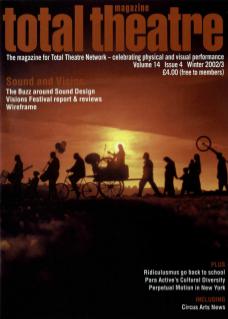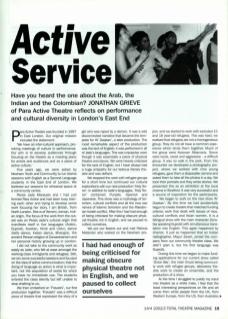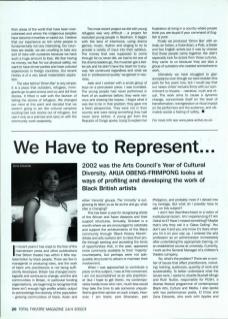Para Active Theatre was founded in 1997 in East London. Our original mission included the statement:
'We have an inter-cultural approach, provoking meetings of culture in performance. Our aim is to develop audiences through focusing on the theatre as a meeting place for actors and audiences and as a place of active culture.’
Five years ago, we were asked by Newham Youth and Community to run drama sessions with English as a Second Language students in the East End of London. We bartered our sessions for rehearsal space at a community centre.
Persis Jade Maravala and I had just formed Para Active and had been busy training each other and trying to develop some work focusing her story. I am British, from North London. She is of Yemeni, Iranian, Indian origin. The focus of the work from the outset was on Persis Jade's cultural origin that manifests itself in five languages (Arabic, Gujerati, Avestan, Hindi and Urdu), dance (belly dance, Indian dance, Bhangra), the ancient Persian religion of Zoroastrianism, and her personal history growing up in London.
I did not take to the community work as easily as Jade, who felt at ease amongst the working-class immigrants and refugees. Still, we ran some successful sessions and focused on the idea of active communication: that the doing of language as action is what is important, not the acquisition of words for which you have no immediate use. The students entered the class silently but left unable to stop chatting to us.
We then embarked on Fravashi, our first production together. Fravashi was a difficult piece of theatre that expressed the story of a girl who was raped by a demon. It was a wild disconnected narrative that became the template for All Daakan, a later production. The most remarkable aspect of the production was the lack of English; it was performed in all of Jade's languages. This was unpopular, even though it was essentially a piece of physical theatre and dance. We were heavily criticised for the lack of English, but I have always had a huge antipathy for our tedious literary theatre and was defiant.
We stopped the work with refugee groups for a short time but continued our cultural explorations with our next production Holy Terror. In addition to Jade's languages, Holy Terror contained Punjabi, Spanish and Japanese. This show was a mythology of terrorism, cultural conflicts and all the now raw nerves of Islamic terrorism and the Palestinian-Israeli conflict. After this I had had enough of being criticised for making obscure physical theatre not in English, and we paused to collect ourselves.
We put our feelers out and met Patricia Melander who worked on the Newham project, and we started to work with excluded 15 and 16 year-old refugees. This was hard; we realised that refugees are not a homogeneous group. They do not all have a common experience which binds them together. Much of the group were Kosovan Albanians. Some were racist, sexist and aggressive – a difficult group. It was no walk in the park. From this encounter we developed a photography project, where we worked with nine young refugees, gave them a disposable camera and asked them to take all the photos in a day. We took their portraits and they wrote stories. We presented this as an exhibition at the local cinema in Stratford. It was very successful and a source of inspiration for the participants.
We began to work on the new show All Daakan. By this time we had accidentally begun to create theatre that matched funding criteria; work that dealt with issues of race, cultural conflicts and Asian women. It is a bilingual show with the main character Zenobia speaking Gujerati with simultaneous translation into English. This again happened by chance. It just so happened that an Indian radiographer, Mayur Zaveri, joined the company from our community theatre class. We didn't plan it, but his first language was Gujerati.
During this time we began to make funding applications for our current show called Onion Bar, the main thrust being community work with refugee groups, laboratory theatre work to create an ensemble, and the production of a show.
At the time I struggled to justify my input into theatre as a white male. I feel that the least interesting perspectives on life and art come from white people from the UK, from Western Europe, from the US, from Australia; from areas of the world that have been overcolonised and where the indigenous peoples have become minorities or wiped out. I believe that our experience as rich white people is fundamentally not very interesting. Our countries are stable, we are unwilling to take any sort of risks with ourselves because we have such a huge amount to lose. We fear having no money, we fear for our physical safety, we want to have dinner parties and have cultured experiences in foreign countries. Our recent history is of a very banal materialistic aspiration.
The idea behind Onion Bar is very simple: it is a place that outsiders, refugees, immigrants go to peel onions and cry and tell their stories. It fitted in well with the fashion of telling the stories of refugees. We changed our mind at this point and decided that we weren't going to act like cultural vampires sucking bad luck stories out of refugees, but use it only as a premise and carry on with the community work separately.
The most recent project we did with young refugees was very difficult – a project for excluded young people in Newham. It began with the best of intentions: using drama games, music, rhythm and singing to try to provide a variety of input into their syllabus. The money that was supposed to come through for us never did, we had to let one of the drama leaders go, the musician got a better job and he didn't have the heart for it anyway. We continued regardless and what we lost in professional quality we gained in rawness.
Jade and I worked with a small group of boys on a percussion piece. I was humbled. The young people had never performed in front of an audience before, they were nervous and shaking like leaves. I forgot what it was like to be in that position; they gave me a fresh perspective. They were not in their country and were doing something they had never done before. A young girl from the Republic of Congo spoke, trying to explain her frustration at living in a country where people think you are stupid if your command of English is poor.
Finally we produced Onion Bar with an Arab, an Indian, a Colombian, a Pole, a Greek and two English actors but it was by chance that these people came together. We didn't especially look for actors from those cultures, they came to us because they are also a group of outsiders who needed somewhere to work.
Ultimately we have struggled to gain acceptance even though we have trodden this path for five years now, but I would say that our ‘raison d'etre' remains firmly with our commitment to theatre – narrative, myth and ritual. The work aims to cause a dynamic change, concentrate itself on the level of transformation, transgression or ritual impact on the performers and the audience, and ultimately avoids a feeling of safety.
For more info see www.para-active.co.uk


